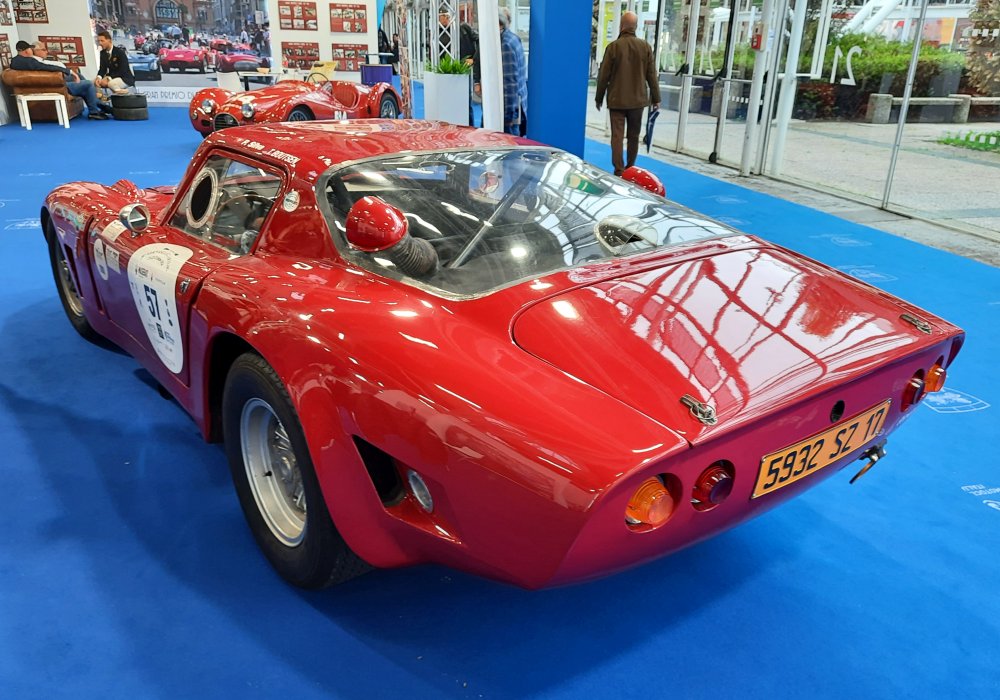Description
The ISO Grifo A3/C was one of the most extraordinary sports cars ever to emerge from Italy’s golden age of motoring — a car that fused the refinement of ISO Rivolta’s engineering with the raw speed and intensity of a competition machine. Conceived in 1963 as the racing counterpart to the luxurious Grifo A3/L, the A3/C — the “C” standing for Corsa, or “racing” — was the creation of the brilliant engineer Giotto Bizzarrini, whose vision was to build a car capable of challenging Ferrari at Le Mans. With its breathtaking aluminium bodywork, lightweight construction, and American V8 power, the ISO Grifo A3/C combined the elegance of Italian design with the muscle and dependability of American engineering. It was both a road-going supercar and a formidable competition machine — one of the fastest and most dramatic automobiles of its era.
The A3/C’s origins lay within a creative but ultimately turbulent partnership between Renzo Rivolta and Bizzarrini. Rivolta, having built the refined ISO Rivolta IR 300 and IR 340 grand tourers, wanted to extend his company’s reach into pure sports cars. He tasked Bizzarrini with developing a high-performance version of the Rivolta platform that could serve both as a competition car and a road-going halo model. While Giorgetto Giugiaro and Bertone styled the luxurious A3/L, Bizzarrini’s A3/C was a wholly different creature — designed not for comfort, but for victory. Bizzarrini’s background as chief engineer at Ferrari, where he had developed the 250 GTO, deeply influenced his approach. He set out to build the ultimate GT racer: front-engined for balance, lightweight for agility, and powered by the most reliable high-output engine available — the Chevrolet small-block V8.
Underneath its dramatic bodywork, the A3/C shared little with the grand touring ISO models. Its chassis was a new tubular spaceframe constructed from small-diameter steel tubes, designed for exceptional rigidity and low weight. The engine was positioned far behind the front axle — so far, in fact, that the car’s configuration was effectively front-mid-engined, giving ideal weight distribution. The front suspension used double wishbones and coil springs, while the rear employed a de Dion axle with twin trailing arms and inboard disc brakes, ensuring superb stability and balance at high speeds. The body, hand-formed in aluminium by the craftsmen of Carrozzeria Drogo in Modena, was as beautiful as it was functional: low, wide, and unmistakably purposeful, with a long bonnet, steeply raked windscreen, and short Kamm-style tail.
Power came from the proven Chevrolet 327 cubic inch (5.4-litre) V8, the same basic unit used in the Corvette, but tuned by Bizzarrini to deliver between 350 and 400 horsepower depending on the configuration. In racing trim, the engine was equipped with high-compression pistons, reworked cylinder heads, and four twin-choke Weber carburettors, all driving through a four-speed Borg-Warner gearbox. With a kerb weight of barely 1,100 kilograms, the A3/C possessed an extraordinary power-to-weight ratio, enabling it to reach speeds in excess of 280 km/h (174 mph). Acceleration was ferocious: 0–100 km/h (62 mph) in around 5.5 seconds — figures that placed it among the fastest road-legal cars in the world.
The A3/C’s aerodynamic design was dictated entirely by performance. The long bonnet channelled air efficiently over the low cockpit and rear haunches, while the flat, abruptly cut tail reduced drag and enhanced stability at high speeds — an idea derived from Kamm’s aerodynamic principles, which Bizzarrini had studied during his time at Ferrari. The car’s low-slung stance and muscular proportions gave it an aggressive presence that still looks otherworldly today. In pure racing form, lightweight Perspex windows and minimal trim reduced weight further, while road-going examples — of which only a few were built — received slightly more interior equipment but remained brutally focused machines.
Inside, the cabin of the A3/C was simple and functional, a world apart from the opulence of the A3/L. Two lightweight bucket seats sat within a sparse cockpit trimmed in bare aluminium and black vinyl. The dashboard contained only essential instruments: a large tachometer, oil pressure and temperature gauges, and a speedometer, though few owners paid much attention to it. Visibility was good thanks to the low scuttle and thin pillars, and the large wood-rimmed steering wheel gave precise feedback. Every detail in the car served a purpose — weight saving, cooling, or control — in keeping with Bizzarrini’s uncompromising philosophy.
On the road and track, the ISO Grifo A3/C was astonishing. Its low centre of gravity, perfect weight balance, and immense torque made it blisteringly fast yet surprisingly tractable. The steering was razor-sharp, the brakes immensely powerful, and the chassis remained composed even at the limit. The car’s stability at high speed was remarkable — a product of both its aerodynamics and its advanced suspension geometry. Road testers and racers alike marvelled at its blend of power and finesse, describing it as a car that felt “carved from steel and air.”
In 1964 and 1965, a small number of A3/Cs competed in endurance races, including the 24 Hours of Le Mans, where they demonstrated exceptional pace if not always reliability. One example, entered by the French team Ecurie Scirocco, finished 14th overall in 1965, averaging speeds above 170 km/h for much of the race. The car’s combination of speed, stability, and mechanical durability earned it great respect among engineers and drivers, even as it struggled for factory support amid the growing rift between Rivolta and Bizzarrini.
That rift eventually ended the car’s career as an ISO. Renzo Rivolta, focused on producing luxury grand tourers, was reluctant to continue backing Bizzarrini’s expensive racing program. By 1965, the two men had parted ways. Bizzarrini retained the rights to the design and continued to produce the car under his own name as the Bizzarrini 5300 GT Strada — a car mechanically identical to the A3/C but bearing his personal badge. ISO, meanwhile, went on to develop the road-focused Grifo series, while Bizzarrini’s creation earned its place among the legends of Italian performance engineering.
Only about 20 ISO Grifo A3/Cs were built under the ISO name between 1963 and 1965, making them among the rarest and most valuable Italian sports cars ever produced. Each was hand-assembled, often differing in detail, with some configured for racing and others for road use. Their rarity, purity of design, and historical significance — as the direct ancestor of the Bizzarrini 5300 GT — have made them icons among collectors and historians.
Today, the ISO Grifo A3/C is celebrated not just as a car, but as an expression of engineering artistry and passion. It represents a moment when Italian creativity, American power, and racing ambition came together in perfect harmony. To see one is to glimpse the transition from the grand tourers of the early 1960s to the supercars that would follow — a bridge between luxury and competition, between art and performance.
The ISO Grifo A3/C remains a monument to Bizzarrini’s genius and Rivolta’s daring — a car that defied convention and created its own category. With its breathtaking lines, thunderous V8, and race-bred soul, it stands as one of the greatest sports cars of its age: an Italian masterpiece born of speed, shaped by intellect, and forever remembered for its unrelenting beauty and power.




